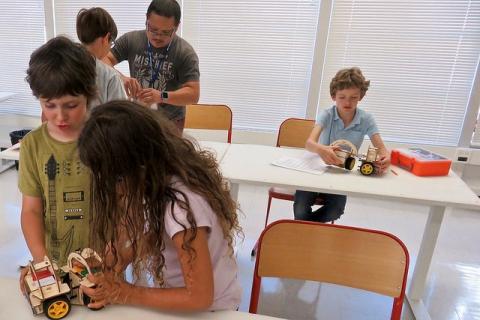Three Ways Lasers Make the Cut in the Classroom

Figure 1. Students assemble customized robots from laser cut components. Source: Fabrice Florin/CC BY-SA 2.0
Tuesday, August 21, 2018
An increasing number of schools are providing makerspaces for their students — places kids can create projects with various pieces of machinery, including laser cutters. Some of that equipment carries a hefty price tag, however, so it is critical educators can show school boards that the devices they want to include in a makerspace can provide an attractive return on investment. Often, they need to prove why a laser cutter belongs in the classroom before the class ever gets to try it out.
Laser Cutters Teach Engineering
Horology — the study of time — is a unique and accessible subject that can expose students to structural, mechanical and other engineering disciplines, as well as art. Clock making is a popular project in design and technology classes found in many schools, although it often focuses on aesthetic design elements. However, the STEM content of a horology project can be highlighted through the use of laser-cutting machinery. Clock mechanisms, for instance, are inexpensive to design; the clock itself can be as intricate or simplistic as a student is inclined to make it. According to a 2013 Loughborough University study on applying laser-cutting techniques through horology, schools have seen success in gaining pupil interest in science and technology through this type of approach.
Lasers Invigorate Art and Design Curricula
Laser cutters can produce complex patterns for sewing class, for making stage costumes or for cutting out intricate mandalas. Felt and other flexible materials can be cut to create puppets and stuffed animals; tiles lined with felt can be used as coasters. Balsa wood can be fashioned into bird houses or clocks, or engraved with pictures or designs. When a cutting device is part of an art program, creative juices flow, alongside the refinement and further development of both mathematics and tactile skills.
Lasers Energize Robotics
Many schools start robotics activities in elementary school and continue them up into the final years of high school. As a result, young children get exposed to computer programming skills and learn the importance of following directions. As older learners, they can understand the depths of applied mathematics and take on advanced technology design. Robotics activities can include etching printed circuit boards (PCBs) from a piece of copper-clad board, coated with spray paint and blasted with a laser. A laser engraver can also cut wooden models and etch logos into robot bodies. All age groups are afforded opportunities to practice communication, judgment and decision making through this type of curriculum.
Summary
Laser cutters add a dimension of interactive learning to the classroom. They allow teachers to incorporate a hands-on approach, which studies have shown lead to better mastery of complex concepts. For many schools, laser cutters can help reimagine curricula, helping to nurture a connection between the digital mindset and the physical mindset. Students who can transfer their designs into physical reality gives them the experience of “making.” It’s a connection that can be parlayed into a pursuit of engineering, science, art, architecture and much more.
Source: www.epiloglaser.com[/vc_column_text][/vc_column][/vc_row]









 This content was provided by Epilog Laser. In business since 1988, Epilog Laser has worked hard to become the leader in the laser engraving, cutting and marking industry. We are innovators. We are problem solvers. We are committed to designing and manufacturing the highest-quality laser systems, right here in our Golden, CO headquarters.
This content was provided by Epilog Laser. In business since 1988, Epilog Laser has worked hard to become the leader in the laser engraving, cutting and marking industry. We are innovators. We are problem solvers. We are committed to designing and manufacturing the highest-quality laser systems, right here in our Golden, CO headquarters.








